| INDEX | 1300-1599 | 1600s | 1700s | 1800s | 1900s | CROSS-ERA | ETHNO | |
| MISCELLANY | CONTACT | SEARCH | |
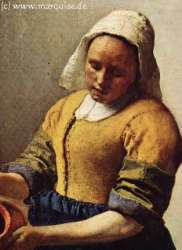 Introduction
Introduction
First off, an introduction to the historical background of this pattern and possible adaptations.
This is a pattern for a petticoat of circa 1600-1700, but it can be adapted for lower class wear until about 1820, with some adjustments. The period and class that you are making the petticoat for will determine as much about it as what is to be worn with. Length is the first and most important consideration; if you are doing an aristocratic persona it should be to the ground in front with a very small train for c. 1620-1680, and with longer train for court wear or for 1680-1700, bearing in mind of course that status determined the length of the train. I found on the L'age D'or website that in 1710 an act was passed which stated that a train could be 11 feet for the Queen of France, that of the the royal princesses 9 feet, more distant relations of the king, 7 feet, princesses who were not daughters of the king 5 feet, and duchesses 3 feet. This also apparently goes for court dress, at least in France, for the entire later century. All of this excess material was looped over the left arm while walking, which must have been quite heavy but at least kept it out of the way of dirt and other people's feet, which as any re-enactor knows can drive one mad.
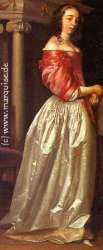 If
you are doing a lower class persona, however, the considerations are practical
rather than status related. Lower class women of the period seem never to have
had floor length skirts(actually, many aristocratic women didn't either for
everyday wear, according to Restoration London). In fact, period engraving of
street criers show skirts as short as a few inches above the ankle, but no longer
than the shoetops. Also, the idea of lower class meaning plain is not to be
taken at face value. The kitchen maid in Restoration London quite clearly has
trim of some kind on her petticoat and Vermeer's women often have bands of contrasting
trim on their clothes. Also, the lower class love of bright colours is evident
in all period paintings, particularly those of the Dutch genre painters. Red
petticoats seem to have enjoyed an especial popularity, even among Puritans
and the lower classes (Vermeer's kitchen maid is wearing one). This should not,
of course, be taken to mean that a peasant character has no status restrictions
whatsoever. For a good look at the sumptuary laws, I would refer you to the
Sumptuary laws section of Drea Leed's website at http:/costume.dm.net/sumptuary.html.
While these are much earlier than our period, they do give a general idea of
what could and could not be worn by any given class. Also, as the last sumptuary
law in Great Britain was passed in 1621 in Scotland, they can be presumed to
give a reasonably accurate idea even after their own period. One exception is
cotton, which was not worn extensively in Europe until the late part of the
17th century, which made it a quite highly prized fabric so it is not a good
choice for everyday petticoats, even for the aristocracy. Having said that,
however, many people will argue that it was common, was unknown, or other than
stated here. This is not meant to be an absolute rule book.
If
you are doing a lower class persona, however, the considerations are practical
rather than status related. Lower class women of the period seem never to have
had floor length skirts(actually, many aristocratic women didn't either for
everyday wear, according to Restoration London). In fact, period engraving of
street criers show skirts as short as a few inches above the ankle, but no longer
than the shoetops. Also, the idea of lower class meaning plain is not to be
taken at face value. The kitchen maid in Restoration London quite clearly has
trim of some kind on her petticoat and Vermeer's women often have bands of contrasting
trim on their clothes. Also, the lower class love of bright colours is evident
in all period paintings, particularly those of the Dutch genre painters. Red
petticoats seem to have enjoyed an especial popularity, even among Puritans
and the lower classes (Vermeer's kitchen maid is wearing one). This should not,
of course, be taken to mean that a peasant character has no status restrictions
whatsoever. For a good look at the sumptuary laws, I would refer you to the
Sumptuary laws section of Drea Leed's website at http:/costume.dm.net/sumptuary.html.
While these are much earlier than our period, they do give a general idea of
what could and could not be worn by any given class. Also, as the last sumptuary
law in Great Britain was passed in 1621 in Scotland, they can be presumed to
give a reasonably accurate idea even after their own period. One exception is
cotton, which was not worn extensively in Europe until the late part of the
17th century, which made it a quite highly prized fabric so it is not a good
choice for everyday petticoats, even for the aristocracy. Having said that,
however, many people will argue that it was common, was unknown, or other than
stated here. This is not meant to be an absolute rule book.
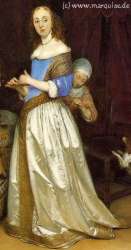 As
for the considerations imposed by period, one is how your garment is pleated.
If you are doing 1620-30, then cartridge pleating will produce more the right
effect. For 1630-75 it is the choice of the wearer and the nationality of the
costume (Dutch costumes have a hang more suggestive of cartridge pleating, whereas
English and French skirts are narrower at the hip which suggests knife pleats).
For after 1680, it should be knife pleated to give the very narrow, vertical
line of the period.
As
for the considerations imposed by period, one is how your garment is pleated.
If you are doing 1620-30, then cartridge pleating will produce more the right
effect. For 1630-75 it is the choice of the wearer and the nationality of the
costume (Dutch costumes have a hang more suggestive of cartridge pleating, whereas
English and French skirts are narrower at the hip which suggests knife pleats).
For after 1680, it should be knife pleated to give the very narrow, vertical
line of the period.
If you are doing lower class, cartridge pleating is probably more accurate as
it is faster to do and one doubts that a peasant woman would have had the time
to arrange knife pleats.
For more information on pleats, their construction and the finished effect, go to the Pleating Tutorial at the end of this article.
Also, the event you are doing will also determine the length of the petticoat. We do a fairly workmanlike demonstration of cooking, but we have an aristocratic persona, so our trains dragged in the mud and fire pits and the skirt had to live most of the weekend looped up, revealing some mighty plain underpetticoats. My suggestion, then, is to make sure you have at least one (washable) petticoat for any aristocratic persona, so that if the outer petticoat must be looped up, it won't be a problem. Failing this, you can simply follow the everyday style of a petticoat with no train. All this mud and dirt is, I think, why working-class women's skirts never reached the ground or were trained and why even an aristocratic woman pinned her overskirt back if she had one, and looped up her petticoat when she was outdoors. The pattens and galoshes worn at this period would also have raised the skirts above the mud.
Now, at last, on to the pattern. It is extremely straightforward, though the introduction would not suggest that.
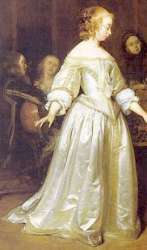 First,
you will need 3-4 metres of fabric 45in (~115 cm) wide, or if you are tall or
want some left over, 60in (150 cm) wide. Fabric selection is the most important
thing you can do to have it look authentic. The rule here is, modern fabrics
cannot be fooled into looking period (been there) and if you want something
with a satin look but don't have a fortune to spend, so-called silk shantung
works quite well and is affordable, or baroque satin. Wool can be simulated
fairly convincingly with a cheaper (and softer) wool/poly blend. Also, upholstery
brocades work, are relatively inexpensive, and authentic for almost the entire
period, but be aware that it can't be the kind with a plastic like back. Somewhat
surprisingly, Aphra Behn and Etherege both are quoted in a History of Underclothes
as mentioning flannel for petticoats. Sewing the petticoat is simple, but it
would be wise to leave about 8 hours for the cutting and sewing.
First,
you will need 3-4 metres of fabric 45in (~115 cm) wide, or if you are tall or
want some left over, 60in (150 cm) wide. Fabric selection is the most important
thing you can do to have it look authentic. The rule here is, modern fabrics
cannot be fooled into looking period (been there) and if you want something
with a satin look but don't have a fortune to spend, so-called silk shantung
works quite well and is affordable, or baroque satin. Wool can be simulated
fairly convincingly with a cheaper (and softer) wool/poly blend. Also, upholstery
brocades work, are relatively inexpensive, and authentic for almost the entire
period, but be aware that it can't be the kind with a plastic like back. Somewhat
surprisingly, Aphra Behn and Etherege both are quoted in a History of Underclothes
as mentioning flannel for petticoats. Sewing the petticoat is simple, but it
would be wise to leave about 8 hours for the cutting and sewing.
Take your fabric, cut it in half widthwise, measure from waist to ground in
front, take one of the pieces and cut it off to that length plus 2 cm (1in).
Repeat with other piece, measuring for a train if desired. As mentioned previously,
if you want a shorter petticoat measure to where you wanted plus 2 cm. Sew up
side seams to within 15 cm (6in) of the top, then add a placket around that
bit or hem it. If you use a placket, be sure that the strip is wide enough or
you'll have those nasty little holes where it pulled away from the fabric. After
this, you have some choices - you can make a waistband that closes with ties
on the sides (very easy to put on alone, but not documentably period) or you
can make a waistband in one piece, make a 15cm slit in the back, finish that
and have a back-fastening skirt. Either way it is important to make your waistband
before you pleat your skirt. We made our waistbands by cutting a 15cm wide strip
of fabric the waist measurement plus 8 cm (~3in), ironing a small crease in
the long edges, then basting
interlining half the width of the waistband to the wrong side of the fabric
(if you are making a side closing petticoat, you'll need to cut the waistband
pieces in half) then finishing the short edges. If you are using ribbons, sew
them in now, to the unlined half of the waistband on the inside, when you finish
the ends. Make sure that your ribbons will be right side out when it is finished.
If you are using hooks, simply finish the ends. I have also found in History
of Underclothes a reference to buttoned petticoats. I cannot find any more specific
information on the topic. Next, you will need to pleat or gather your skirt
at the waist. If you are using knife pleats, you will likely end up with a skirt
that is WAY bigger than your waistband. Don't panic, simply adjust the gathering
threads until it fits. Then, carefully attach your petticoat to the waistband,
hem it, and attach hooks if you are using them, and you're done.
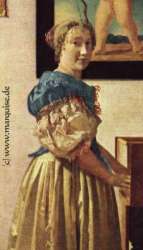 A
few notes on the authenticity of this pattern: The ribbon ties are period for
the seventeenth century, but the side closing waistband is our invention, although
it does seem consistent with the period sewing techniques, which are relatively
simple. Also, hand hemming adds much to the authenticity of the petticoat, though
a blind hemstitch on a machine will have the same effect. If this is your first
petticoat or you are in a hurry to get it done, machine hemming is all right
(after all, who is going to have their eyes riveted on your petticoat hem? If
they do, John Evelyn must have come back from the dead). This pattern can be
made authentic in everything except that the fabric is used with the grain running
vertically instead of horizontally, but it does look right when the light breaks
on it. Period petticoat patterns were set up to accommodate much narrower fabric
(period silks were usually 48-55cm wide). For trim, it can go around the hem
or around the hem and up the centre front. After about 1675, a flounce can be
added to an upper-class skirt, and for the very late century, that hip level
flounce can give a more period effect. I have never tried these, so I have no
specific advice.
A
few notes on the authenticity of this pattern: The ribbon ties are period for
the seventeenth century, but the side closing waistband is our invention, although
it does seem consistent with the period sewing techniques, which are relatively
simple. Also, hand hemming adds much to the authenticity of the petticoat, though
a blind hemstitch on a machine will have the same effect. If this is your first
petticoat or you are in a hurry to get it done, machine hemming is all right
(after all, who is going to have their eyes riveted on your petticoat hem? If
they do, John Evelyn must have come back from the dead). This pattern can be
made authentic in everything except that the fabric is used with the grain running
vertically instead of horizontally, but it does look right when the light breaks
on it. Period petticoat patterns were set up to accommodate much narrower fabric
(period silks were usually 48-55cm wide). For trim, it can go around the hem
or around the hem and up the centre front. After about 1675, a flounce can be
added to an upper-class skirt, and for the very late century, that hip level
flounce can give a more period effect. I have never tried these, so I have no
specific advice.
Finally, you may want to make more than one petticoat for each costume so that you can keep it looking fresh. This is a very period thing to do as it alters the appearance of the gown quite a bit without much expenditure of time or money.
Cartridge Pleats: This is basically a running stitch, pulled up to form pleats. To do it, thread a needle (not a over large one or the fabric will pull) with a substantial length of thread, then make even running stitches. For those of you with no pleating experience, a running stitch is just like a regular hand stitch except that the thread is not pulled through until no more fabric will fit on the needle. This is quite simple and easy to do once you have the hang of it.
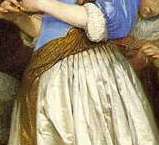 Knife
Pleats: While these take more time and thought than cartridge pleats, they are
also period and give a lovely, sumptuous effect. To do, thread needle as above,
then, using your thumb as a guide, pinch up a piece of fabric that size and
lay it over to one side. Then put a small stitch in to hold it in place. Repeat
until all the fabric is pleated. These stitches will not be removed, so be sure
that your thread comes close to matching the fabric, although some garments
in the 18th century show white or otherwise non-matching thread colours.
Knife
Pleats: While these take more time and thought than cartridge pleats, they are
also period and give a lovely, sumptuous effect. To do, thread needle as above,
then, using your thumb as a guide, pinch up a piece of fabric that size and
lay it over to one side. Then put a small stitch in to hold it in place. Repeat
until all the fabric is pleated. These stitches will not be removed, so be sure
that your thread comes close to matching the fabric, although some garments
in the 18th century show white or otherwise non-matching thread colours.
Also, bear in mind that two needles produce a longer pleat than one, and that by placing the stitches of knife pleats lower, you can eliminate bulk at the waist, thus avoiding the ship-in-full-sail effect that is seen in the 19th century. Placing the first row of stitches about 2in (5cm) below the top of the fabric produced an effect suitable for 1670-1700, that is, narrow at the hip and pooling on the ground. Cartridge pleats will retain some fullness at the hip, even if done with two needles. This is not a drawback if your petticoats need to hold up a heavy overskirt or if you want a more rounded shape.
Before I move on to resources, I would like to mention a few online places to go for how-tos on other 17th century women's garments. First of all, I know that many websites have articles on making a smock, but most do not cover how to make one that is adaptable for 17th century wear. However the article at http://marquise.de/en/1700/howto/18chemise.shtml is quite lucid and accurate to my knowledge and although it is 18th century, it could be 17th century with just a few minor adjustments. For a howto on stays which could be made into a bodice, go to http://www.12eyes.co.uk. If you are doing post-restoration and need a bodice, I have suffered with you there, but alas, did not not find any accessible information on the internet. Also, for a good demo on cavalier (women's) collars go to http://vertetsable.com. For the nitty-gritty detail freak with a talent for knitting (definitely not me) there is a knitted stocking pattern at http://www.dabbler.com. If you don't know a knitting needle from a garden hose, there is a pattern for full-fashioned linen stockings coming soon at http://vertetsable.com. While both of these patterns are Elizabethan rather than Baroque, stockings can be presumed not to have changed much.
This is by no means an exhaustive list of all resources for the period, but
only of ones which we personally have read.
Restoration London by Liza Picard. The best general resource for the period, wonderfully detailed and uses many primary sources. Its only drawback is a lack of structural information on clothing. A lovely read for anyone wishing to bring London to life in the period, who wants to know what it felt like to stand on a bustling London street corner in the decade 1660-70 or slightly earlier or later. Our favourite book on the era! It's alive, much like the city itself, and near-perfect, or as close as any book can come on the subject of daily life.
Fashion in Detail by Avril Hart and Susan North. Wonderful resource for very specific queries on construction. This is where I found the reference to petticoats being straight lengths of material gathered on a waistband. No surviving petticoats there, so a small amount of information, but still a lovely book, literally(the photographs are gorgeous). Charles I would have liked the look of this one…
400
Years of Fashion by Natalie Rothstein, ed : Not overmuch on the post-Restoration
era and ,again, no skirts from the 17th century, but lovely and with good descriptions
of period techniques. Bit short for our taste..an overview of fashion rather
than a guide to recreation.
History of Fashion by Carl Kohler. A detailed reference for the period, with
many photos not seen very often. It also includes a pattern for a "late
17th century corset" which is a good starting point for a bodice or a pair
of stays for 1640-1700. While it needs some adjustments and may be difficult
to size up, it does at least provide a cutting diagram.
What People Wore by Douglas Gorsline. While this may not seem very accurate
at first, most of the images come from actual, contemporary sources. It provides
a good selection of alternatives to styles seen in portraits, as well as showing
outdoor wear for most eras. An introduction for each period, but no other text
except captions. The drawings speak for themselves, though.
History
of Costume by Braun and Schneider. B/w costume sketches, some traceable
to other sources, some I've never seen before, but nothing grossly inaccurate.
Good for French costume as it shows the differences between various countries'
interpretations of the styles. This book has absolutely no editorial, no introduction,
nothing.
The Illustrated Encyclopedia of Costume and Fashion by Jack Cassin-Scott. Accurate I suppose except for those hideous colours, unless you are a herald, you won't have seen this many in one place in your life. The editorial is questionable, but the glossary occasionally comes in handy.
The
History of Underclothes by C. Willet and Phillis Cunnington. A good
resource for any type of underwear, well researched but too brief. However,
each paragraph tells the reader something not often found in other sources.
Well worth the price.
The
Art of Dress by Jane Ashelford. A beautiful book with some lovely extant
garment photographs, very good for details or an entertaining read, but not
for garment construction.
Also, many art books with the Dutch artists in will provide a better look at post-Restoration clothing than many costume books.
I have included these because while many people may find these books hard to find, anyone reading this article has access to a website. Note: these reviews are not based on any members' only or password protected sites, only ones open to all comers.
www.kipar.org: A good overview of costume, but as stated by the disclaimer, not intended for costume study. Heavily weighted toward the late Stuart era, so information pre-1660 is hard to find there. However, the section on etiquette is quite helpful, as is the section on food, at least for a detail freak like me.
www.costumes.org : Wonderful site for links and also has articles of the author's own. Its main disadvantage is the amount of time it takes to load on an older computer.
www.reconstructinghistory.com Good site for photographs of reproduction garments, but it suffers from a lack of instructions for 17th clothing. Also sells patterns for 1630's.
www.vertetsable.com While most of the articles here refer to 16th century costuming, some, such as the corset pattern, could be adapted for the early 17th century, while others, such as the cavalier collar demo, are 17th century and quite accurate. Good basic drafting instructions and information on making accessories, such as fans.
http://stringpage.com/old/string.html While this resource centres on a very specific area of costume, it is a great resource for any type of cord or braid, some of which is still relevant for the 17th century. Most of these techniques require little or no equipment, so they make a fun rainy afternoon project.
http://www.12eyes.co.uk An excellent resource for information on English Civil War dress, re-enacting etc. The stay page is especially good as it has a diagram for cutting a pair of 1640's stays. The accompanying article gives a comprehensive look at the stays, their construction, and their history.
http://www.marquise.de I am sure that there is some rule against writing up your host site, but it's too good to miss. The picture gallery is absolutely fantastic, well researched, with a variety of nationalities represented. Not least, the pictures are true to colour and high enough resolution to use for study. One of the only sites for Restoration pictures that show women in day dress and not the evil gold dressing gown. All in all, the best site for people like us, who love the 17th century, want to be as accurate as possible, and want lots and lots of choices.
Comment from the website host: Thanks for all the praise in the resources
section!
Content, layout and images of this page
and any sub-page of the domains marquise.de, contouche.de, lumieres.de, manteau.de and costumebase.org are copyright (c) 1997-2022 by Alexa Bender. All rights reserved. See Copyright Page. GDPO
This work is licensed under a Creative Commons License.